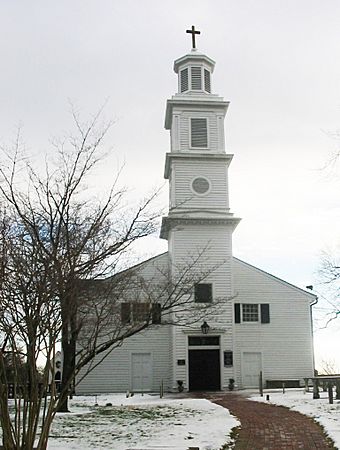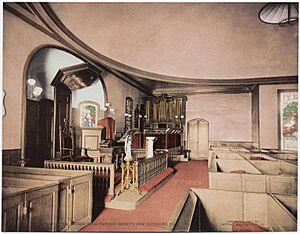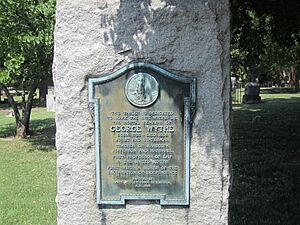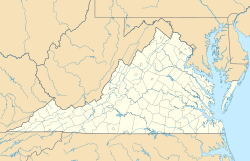St. John's Episcopal Church (Richmond, Virginia) facts for kids
|
St. John's Episcopal Church
|
|
|
U.S. Historic district
Contributing property |
|

St. John's Episcopal Church in Richmond, Virginia on a winter day
|
|
| Location | Richmond, Virginia |
|---|---|
| Built | 1741/1611 |
| Part of | St. John's Church Historic District (ID70000884) |
| NRHP reference No. | 66000920 |
Quick facts for kids Significant dates |
|
| Added to NRHP | October 15, 1966 |
| Designated NHL | January 20, 1961 |
| Designated CP | September 15, 1970 |
St. John's Church is an Episcopal church located in Richmond, Virginia, United States. It is the oldest church in Richmond. The church was built in 1741 by Colonel Richard Randolph. The area around it, Church Hill, was named after the church.
St. John's Church is famous because it hosted two important meetings before the American Revolutionary War. It was here that Patrick Henry, one of America's Founding Fathers, gave his famous speech. He ended it with the powerful words, "Give me liberty or give me death!" The church is recognized as a National Historic Landmark.
Contents
Church History
Early Beginnings at Henricus
The very first church connected to St. John's was the Henrico Parish Church. It was first located in a settlement called Henricus, founded in the Virginia Colony in 1611. This was a time when the Anglican Church was the official church of the English Crown.
Henricus was known for being a place of "firsts." It was the first place to give land to individuals. It also had the first "College" in colonial Virginia. This school was meant to educate both colonists and Native American children.
It was at Henricus that the colonists held Pocahontas captive. She was the daughter of Chief Powhatan, a powerful Native American leader. During her time there, the church's first minister, Rev. Alexander Whitaker, taught her about Christianity. She also improved her English skills and was baptized as "Rebecca."
Pocahontas later married John Rolfe. He started a large farm called Varina Farms across the James River. Rolfe brought sweet Spanish tobacco seeds to Virginia. This new tobacco quickly became very popular.
In 1617, Reverend Whitaker drowned in the James River. In 1619, Henricus became part of a larger area called Henrico Cittie. However, in 1622, during the Indian massacre of 1622, Henricus and its church were completely destroyed. About a third of all colonists in Virginia were killed.
Henricus was never rebuilt. Its old location was found in the late 1900s. Today, there is a historical park there.
Moving to Varina
Even after Henricus was destroyed, the colony continued to grow. A small village grew around John Rolfe's Varina Farms. This area became known as Varina. In 1634, Henrico County was formed, and Varina became its main town. In those days, church areas (parishes) matched county boundaries.
A famous leader of Henrico Parish was Reverend Dr. James Blair. He was the highest-ranking religious leader in the Virginia Colony. He helped start the College of William and Mary. This new college was built in a safer, fortified place called Middle Plantation, which later became Williamsburg.
The exact locations of the church buildings in Varina are not known. A later church building was built a few miles east of Varina Farms. The only part of that church still existing is the bowl of the baptismal font. It is now used at St. John's Church.
The Church in Richmond
The Henrico Parish Church moved to Richmond in 1741. It was built in what is now the Church Hill neighborhood. The land was given by William Byrd II. He also gave timber for the church and wood for the bricks. In 1752, Henrico County's main offices also moved from Varina to Richmond.
Colonel Richard Randolph (1686–1748) built the new church. He was the great-uncle of Thomas Jefferson. The first part of the church was finished on June 10, 1741. This part is still the middle section of the church today. In 1772, a large addition was built on the north side. This changed the church's direction, and the altar was moved.
Many wooden churches like this one existed in Virginia before the American Revolution. Only four of them are still standing today.
The Second Virginia Convention

The Virginia colonial government, called the House of Burgesses, was dismissed by the royal governor. This happened because of growing problems that led to the American Revolutionary War. The Burgesses then met as a temporary government in Williamsburg. But because the governor had loyal British forces nearby, they decided to hold their next meeting in Richmond.
On March 23, 1775, the Second Virginia Convention began at St. John's Church. Peyton Randolph was the leader of this meeting. The church's minister, Reverend Miles Selden, was chosen as the Chaplain. He was known as the "Patriot Parson."
Among the 120 delegates were important figures like Thomas Jefferson and George Washington. Other notable delegates included Benjamin Harrison V and Richard Henry Lee. The main discussion was about whether to create a local army (militia). This militia would help resist the British Government under King George III.
Patrick Henry, a delegate from Hanover County, spoke strongly in favor of forming a militia. His powerful speech, ending with "Give me liberty or give me death!", convinced the others.
Later, on May 15, 1776, the House of Burgesses decided that Virginia's delegates in the General Congress should propose that the colonies declare themselves free and independent states.
It's also important that this convention allowed Baptist ministers to serve as chaplains for soldiers. This was an early step toward freedom of religion in what became Virginia. After the war, the Anglican Church was no longer the official church. The Episcopal Church of the United States was then formed.
The Third Virginia Convention
The Third Virginia Convention was held at St. John's Church on July 17, 1775. Its goal was to organize Virginia's troops and war efforts. George Washington had been named the head of the American Army. The delegates recognized Patrick Henry's important role in preparing the colony for war. He was then named the first Governor of Virginia.
During the Revolutionary War
In January 1781, during the American Revolutionary War, General Benedict Arnold occupied Richmond. He was a traitor who had joined the British side. His troops stayed in St. John's Church during this time.
Visiting St. John's Church

St. John's Church is still an active church today. It also welcomes many visitors as a historic site.
Many important people are buried in the churchyard. George Wythe, America's first law professor, is buried here. He also signed the Declaration of Independence. Elizabeth Arnold Poe, the mother of famous author Edgar Allan Poe, is also buried in the churchyard. Her exact burial spot is not known, but a memorial marks the general area.
There is a gift shop in the churchyard. Guided tours start from there. These tours take you inside the church and explain the events that led to the Second Virginia Convention. They also cover Patrick Henry's famous speech and his political life.
You can even see reenactments with professional actors in 1700s costumes! These are offered on Sundays at 1:30 p.m. from Memorial Day to Labor Day. They are very popular and often have over 100 people watching. The Walter W. Craigie Speaker Series also brings speakers to the church to talk about history.
See also




